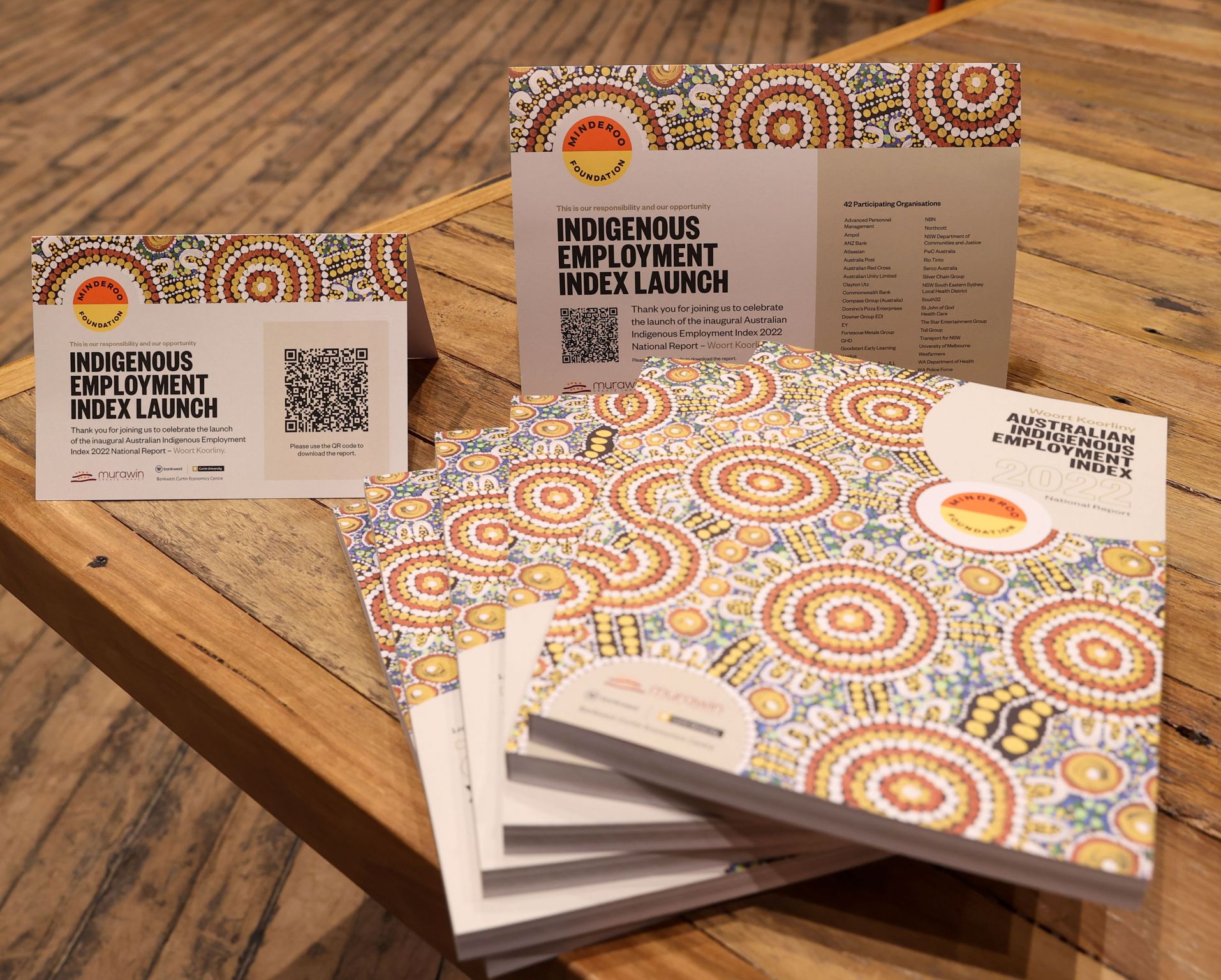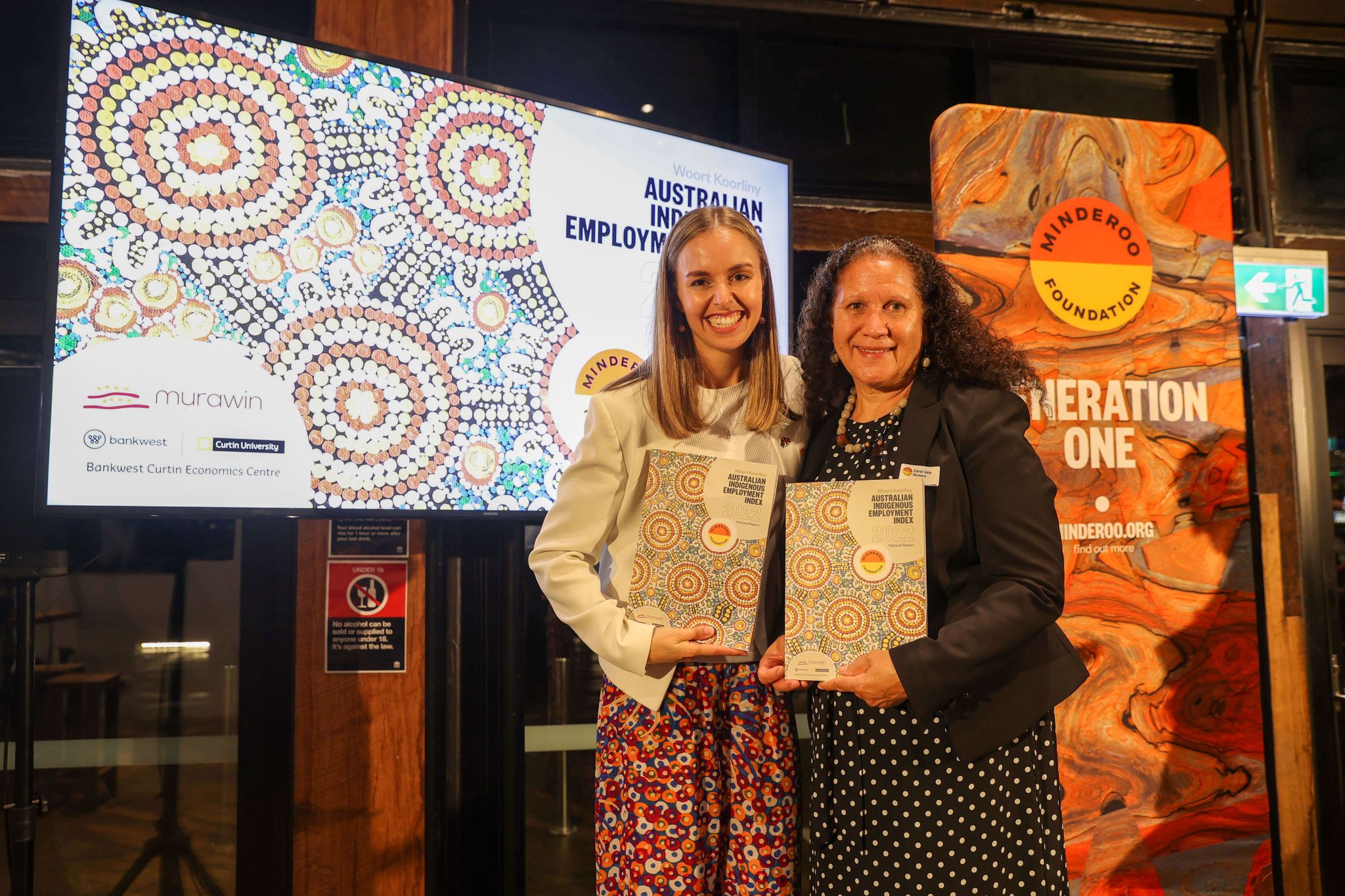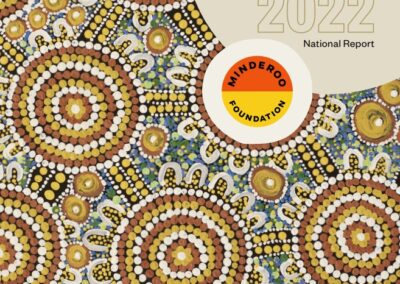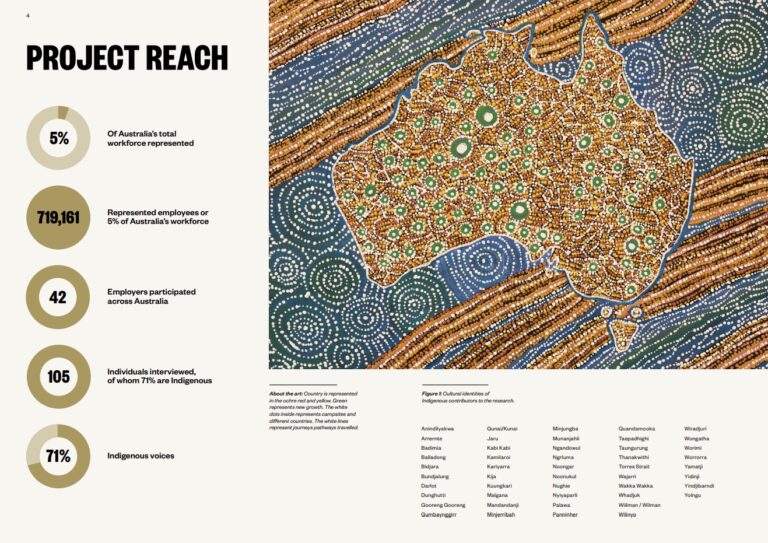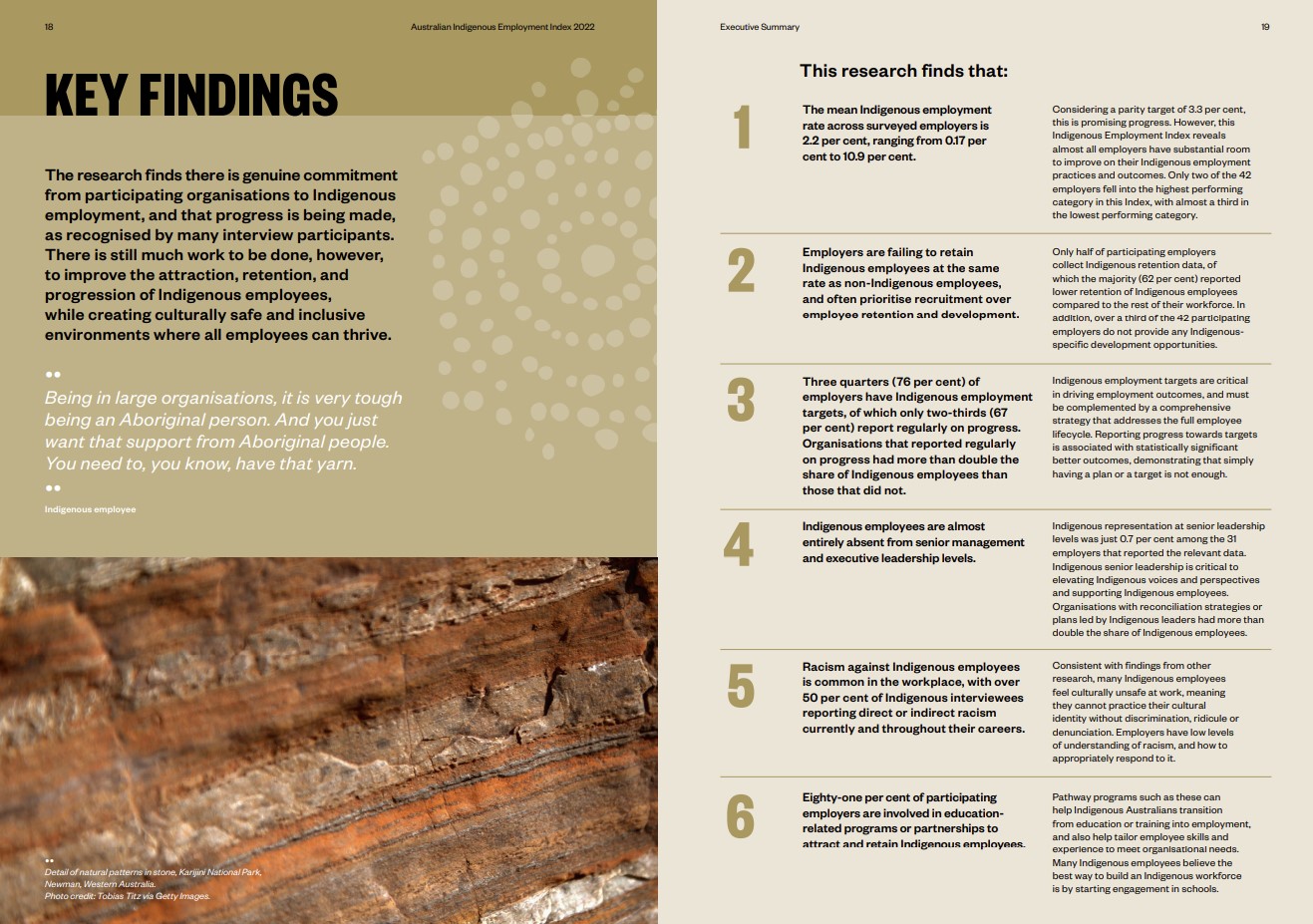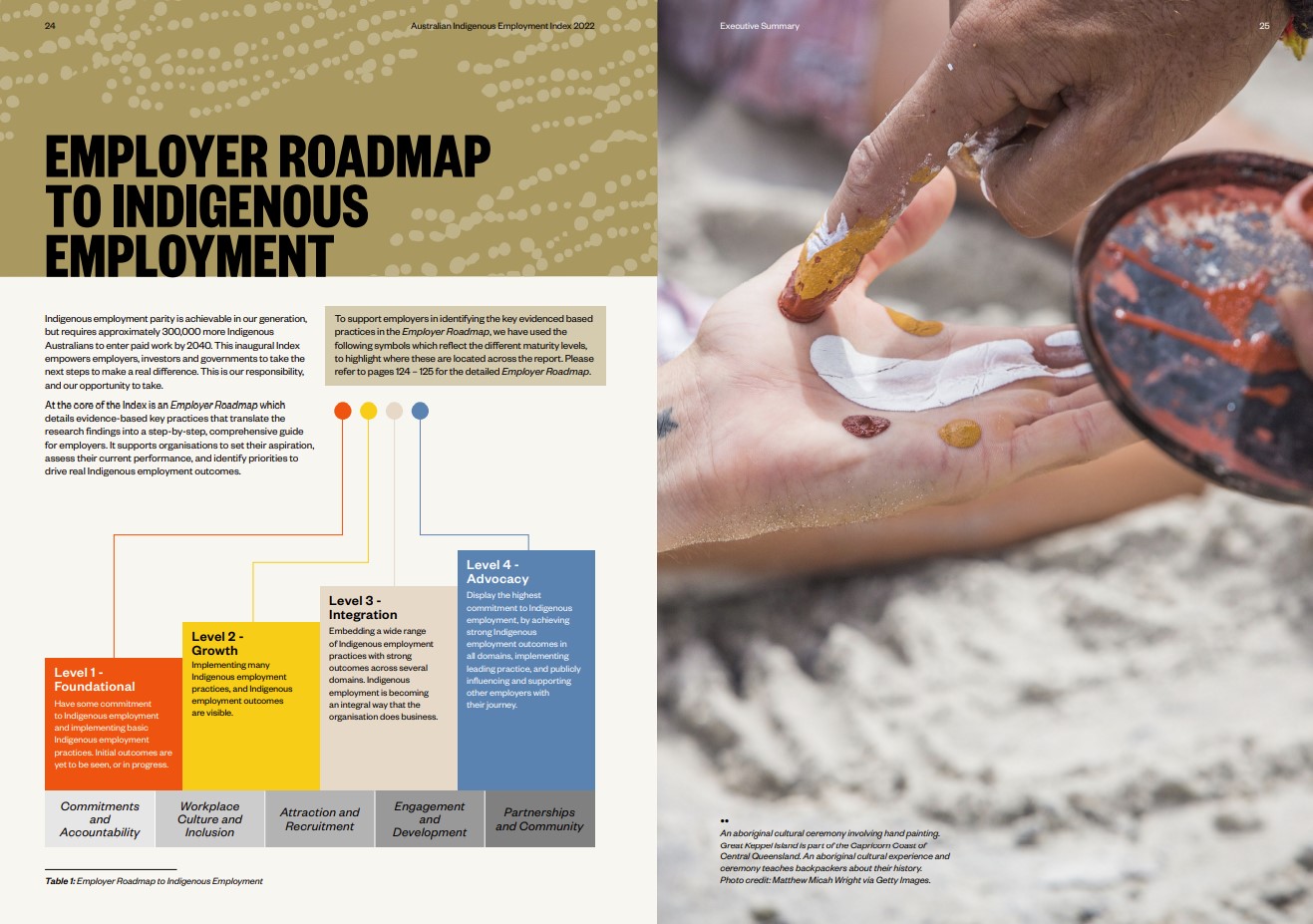
Murawin contributes to Australian-first National
Indigenous Employment Index highlighting the desperate
need to close the employment gap
7 June 2022
Employers need to do more to attract, train, retain and promote Indigenous employees, according to ground-breaking research that is outlined in the new report which lifts the lid on Indigenous employment practices at some of Australia’s biggest organisations.
The Australian-first Indigenous Employment Index was launched on 23 May 2022 by the Minderoo Foundation. The initiative surveyed 42 of the nation’s most significant employers, accounting for more than 700,000 workers.
The Indigenous Employment Index (IEI) was commissioned and led by Minderoo Foundation’s Generation One initiative, which aims to end Indigenous employment disparity in one generation. The research was jointly conducted by Murawin and Bankwest Curtin Economics Centre (BCEC), who also co-authored the Index. Murawin undertook the qualitative research and heard many stories from Indigenous and non-Indigenous employees of what they believe is critical to creating safe workplaces that will see Indigenous Australians thriving and achieving successful employment outcomes.

Murawin collaborated with BCEC and Generation One to complete highly extensive surveys of each employer, plus more than 100 interviewees, to inform the report’s findings.
Research principles
This research was grounded in Indigenous ways of thinking, underpinned with cultural understanding and insights. All research undertaken was delivered with principles of being, as informed by Murawin social research. Respect, reciprocity, and relationships are the key principles embedded in the Research, defined by a set of common principles of a rights-based approach. The team used the common principles outlined by the Australian Human Rights Commission, namely, to ensure everyone has the right to participation, accountability, non-discrimination and equality, empowerment, and legality.
Principles of cultural understanding and insight.
Key findings
Murawin facilitated a workshop to test and validate findings ensure confidence in the research responses, findings, and outcomes, as well as facilitate a co-design process to shape the draft Index. The research team facilitated a second testing and validation workshop to relay back to the Expert Advisory Panel the integration and feedback into the report. The key findings were:
1.
Participating employers still need to do more to create parity, with only 2.2% Indigenous employees on average, compared to the general population
of 3.3%.
2.
Employers are failing to retain Indigenous employees at the same rate as non-Indigenous employees, and often prioritise recruitment over staff retention and development.
3.
76% of employers have Indigenous employment targets, of which only 67% report regularly on progress. Organisations that reported regularly on progress had more than double the share of Indigenous employees than those that did not. Indigenous employment targets are critical in driving employment outcomes and must be complemented by a comprehensive strategy that addresses the full employee lifecycle.
4.
Indigenous representation at senior leadership levels was just 0.7% among the employers that reported the relevant data. Indigenous senior leadership is critical to elevating Indigenous voices and perspectives and supporting Indigenous employees.
5.
Racism against Indigenous employees is common in the workplace, with over 50% of Indigenous interviewees reporting direct or indirect racism currently and throughout their careers. Employers have low levels of understanding of racism, and how to appropriately respond to it.
6.
81% of participating employers are involved in education-related programs or partnerships to attract and retain Indigenous employees. Pathway programs such as these can help Indigenous Australians transition from education or training into employment, and also help tailor employee skills and experience to meet organisational needs.

Minderoo Foundation
Minderoo Foundation Chairman, Dr Andrew Forrest AO, and Co-Chair, Nicola Forrest AO, praised the 42 organisations involved in the Index for their courage to have their employment practices reviewed and scrutinised.
“We focus on Australia’s largest employers because only industry has the power to create the jobs and working environments necessary to drive change,” they said. “This Index is a courageous first step by 42 of Australia’s largest employers to understand where we are now, and to collaboratively develop a set of solutions, underpinned by evidence, that accelerate Indigenous employment parity.”
Photo Source: Minderoo Foundation, Generation One.
Caption: Generation One Director, Shelley Cable, and Murawin CEO, Carol Vale.

Generation One
Generation One Director, Shelley Cable, said while employers were making progress towards parity, there was still a long way to go before true parity is achieved and embedded as a standard way of doing business.
“Today, less than half of working age Indigenous Australians are employed — compared to three quarters of non-Indigenous Australians. At the current rate, it will take 200 years to close the gap,” Ms Cable said.
“Among its key recommendations, the Indigenous Employment Index finds that one-off measures to create Indigenous jobs must give way to a more comprehensive and systemic approach. Authentic commitments, tailored strategies with targets, and a broader definition of Indigenous employment success that includes retention, safety, progression, and partnerships are critical to better Indigenous employment outcomes,” she said.
One major barrier to closing the Indigenous employment gap is the blind spot that exists in Indigenous employment data, research, and evidence.
“At present, the only comprehensive measure of Indigenous employment is the Census, collected once every five years. Similarly, many employers do not have robust data or visibility of their Indigenous workforce and are therefore ill-equipped to drive Indigenous employment parity with confidence,” Ms Cable said.
This Index is the first research of its kind to measure and identify practices within large organisations that increase and improve Indigenous employment outcomes, and that elevates and centres Indigenous voices on the journey towards true employment parity. It provides a critical review of what employers are doing well, the concrete steps organisations can take to drive parity, and how to improve the experiences of Indigenous employees.
Ms Cable said the report served as a baseline assessment of Indigenous employment parity amongst 42 large employers.
“This report does not have all the answers,” she said. “The findings shared in this report are only part of the story, and help to inform employer, government and investor approaches needed to meet the needs of diverse Indigenous stakeholders.
“Subsequent Indices will be dedicated to expanding the breadth of this research and continuing to promote Indigenous employment outcomes and Indigenous ways of being, knowing and doing.
“While many large organisations are committed to the journey to true Indigenous employment parity, there remains a long way still to go,” Shelley Cable said.
Photo Source: Image Source: Samples from the Woort Koorliny,
Australian Indigenous Employment Index 2022 National Report, Minderoo Foundation,
Murawin, Bankwest Curtin Economics Centre,
https://www.minderoo.org/indigenous-employment-index/downloads/

Murawin
Murawin CEO, Carol Vale said, “Australia’s first National Indigenous Employment Index has finally been released and sadly today, Indigenous Australians remain vastly under-represented or excluded from the workforce.”
“The Indigenous Employment Index is the first comprehensive snapshot of Indigenous workplace representation, practices, and employee experiences ever to be carried out in Australia and Murawin is extremely proud to contribute to this research and co-author the IEI,” Carol said.
“The way our findings have been received, especially by employers, gives us great hope for Indigenous employment parity. I’d like to recognise the Murawin team who worked so diligently on the inaugural Index, and acknowledge the successful collaboration from Minderoo’s Generation One, Bankwest Curtin Economics Centre, the Expert Advisory Panel, and the 42 participating employers, Indigenous organisations and advisers.”
“There is still much work to be done to improve the attraction, retention, and progression of Indigenous employees, while creating culturally safe and inclusive environments where all employees can thrive.”
Following the release of the National Indigenous Employment Index, Murawin is calling for immediate action from employers, governments, and investors to help create Indigenous employment parity.

Join us at the Brisbane release
Along with the Minderoo Foundation’s Generation One team, Murawin will be co-hosting an event in Brisbane on 11 July 2022 to officially release the Index in SEQ.
We encourage all those in our network who are passionate about ending Indigenous employment disparity, to please join us at this event. Event registration details will be released soon.
When: 11 July 2022, 9.30-11.30am
Where: Birrunga Gallery & Dining
For more information: Contact rebecca@murawin.com.au
Find out more
To read the report visit Indigenous Employment Index | Generation One | The Minderoo Foundation


